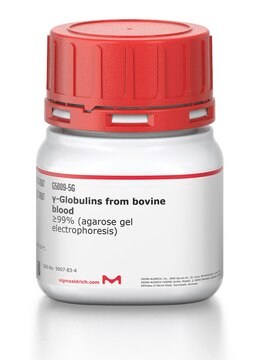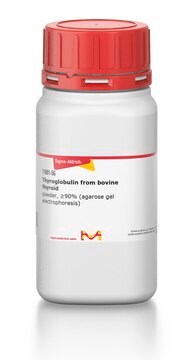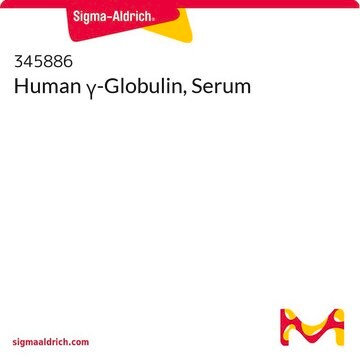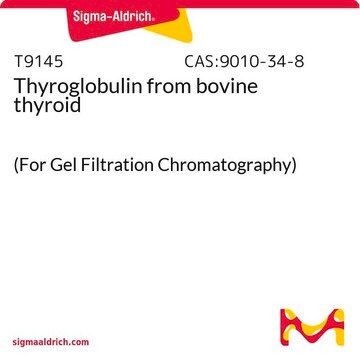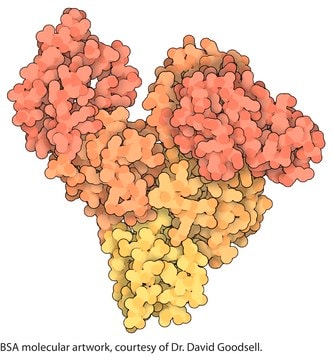SRE0011
γ-Globulines from bovine blood
Suitable for manufacturing of diagnostic kits and reagents, ≥99% (agarose gel electrophoresis)
Synonyme(s) :
γ-globuline bovine
Se connecterpour consulter vos tarifs contractuels et ceux de votre entreprise/organisme
About This Item
Numéro CAS:
Numéro CE :
Numéro MDL:
Code UNSPSC :
12352204
Nomenclature NACRES :
NA.32
Produits recommandés
Niveau de qualité
Essai
≥99% (agarose gel electrophoresis)
Forme
powder
Composition
NaCl, ≤4%
Application(s)
diagnostic assay manufacturing
Conditions d'expédition
wet ice
Température de stockage
−20°C
Vous recherchez des produits similaires ? Visite Guide de comparaison des produits
Description générale
Fraction de protéines plasmatiques riche en anticorps
La gammaglobuline bovine (BGG) est un constituant important du système immunitaire des vaches et autres bovins. La BGG, présente dans le sang des bovins, sert principalement à fabriquer des produits médicaux comme les vaccins, les sérums et les réactifs de diagnostic. La BGG peut aussi servir à traiter certaines pathologies médicales comme l'hépatite B et à stimuler l'immunité chez l'être humain et d'autres animaux.
γ-Globulins are immunoglobulins that contain IgM, IgA, and IgY. They are glycoproteins produced by plasma cells. The immunoglobulins are heterodimeric molecules comprising two light chains and two heavy chains linked together by disulfide bonds.
Application
La γ-globuline bovine a été employée comme agent inducteur immunologique dans des études sur le mécanisme de l′immunotolérance.
γ-Globulins from bovine blood has been used along with polyethylene glycol (PEG) to investigate the kinetics of liquid-liquid phase separation (LLPS) in its temporary and arrested state. It has also been used as a parent solution to prevent bacterial growth and study the antibody system with LLPS and highly elevated protein concentrations in arrested transition.
Actions biochimiques/physiologiques
Immunoglobulins are implicated in the activation of the complement system and the opsonization of microbes for phagocytosis. It is also involved in the neutralization of toxins and viruses and blocks the attachment of microbes to mucosal surfaces. They protect our bodies against fungi, viruses, and bacteria. Immunodeficiency is associated with recurrent infectious diseases.
Notes préparatoires
Prepared from Cohn Fraction II, III
Code de la classe de stockage
11 - Combustible Solids
Classe de danger pour l'eau (WGK)
WGK 3
Point d'éclair (°F)
Not applicable
Point d'éclair (°C)
Not applicable
Faites votre choix parmi les versions les plus récentes :
Déjà en possession de ce produit ?
Retrouvez la documentation relative aux produits que vous avez récemment achetés dans la Bibliothèque de documents.
Les clients ont également consulté
Stefano Da Vela et al.
Soft matter, 13(46), 8756-8765 (2017-11-14)
We investigate the transition of the phase separation kinetics from a complete to an arrested liquid-liquid phase separation (LLPS) in mixtures of bovine γ-globulin with polyethylene glycol (PEG). The solutions feature LLPS with upper critical solution temperature phase behavior. At
Blood
Sturkie's Avian Physiology, 167-191, 167-191 (2015)
Harry W Schroeder et al.
The Journal of allergy and clinical immunology, 125(2 Suppl 2), S41-S52 (2010-03-05)
Immunoglobulins are heterodimeric proteins composed of 2 heavy and 2 light chains. They can be separated functionally into variable domains that bind antigens and constant domains that specify effector functions, such as activation of complement or binding to Fc receptors.
Notre équipe de scientifiques dispose d'une expérience dans tous les secteurs de la recherche, notamment en sciences de la vie, science des matériaux, synthèse chimique, chromatographie, analyse et dans de nombreux autres domaines..
Contacter notre Service technique